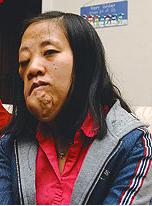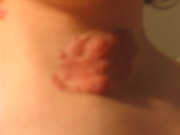Yuka Miyazu, MD(*); T Miyazawa, MD,FCCP; Y Iwamoto, MD and N Kurimoto, MD. Dept. of Pulmonary Medicine, Hiroshima City Hospital, Hiroshima, Japan and Dept. of Surgery, National Hospital of Hiroshima, Hiroshima, Japan.
PURPOSE: Tracheobronchial stenosis caused by neurogenic origin tumor associated with von Recklinghausen's disease are extremely rare, with only ten cases reported in literature. We opted to insert the stent for airway stenosis in patients with von Recklinghausen's disease.
METHODS: Case series. In two patients with von Recklinghausen's disease, Ultraflex stents were implanted for stenosis of the airway using a rigid bronchoscope under general anesthesia at Hiroshima City Hospital.
RESULTS: Immediately after stenting, symptomatic relief of dyspnea was achieved in two patients. Case 1: A 62 years old housewife presented severe dyspnea caused by neurofibroma adjacent to the subglottic region, completely compressing the airway. At first, Dumon stent was inserted. However, because of the complications of secretions, it was necessary to change to an Ultraflex stent. Bronchoscopy was performed two month later, no retention of secretions inside the stent was observed. Case 2: A 12 years old girl presented a week history, of progressive dyspnea. A bulky malignant peripheral nerve sheath tumor on the neck obstructing the pharynx and compromising respiration. Immediately after admission, the patient became shorter of breath necessitating endotracheal intubation. We performed bronchoscopic electrocautery to remove endobronchial tumor, and then we inserted six Ultraflex stents for stenoses of airway from subglottic region to bilateral bronchi.
CONCLUSION: To our knowledge, these are the first and second cases treated by stenting in airway stenosis with von Recklinghausen's disease. Owing to stenting, these patients were saved from imminent suffocation.
CLINICAL IMPLICATIONS: For the management of the compromised airway with yon Recklinghausen's disease, stenting proved to be useful.
COPYRIGHT 2000 American College of Chest Physicians
COPYRIGHT 2001 Gale Group




